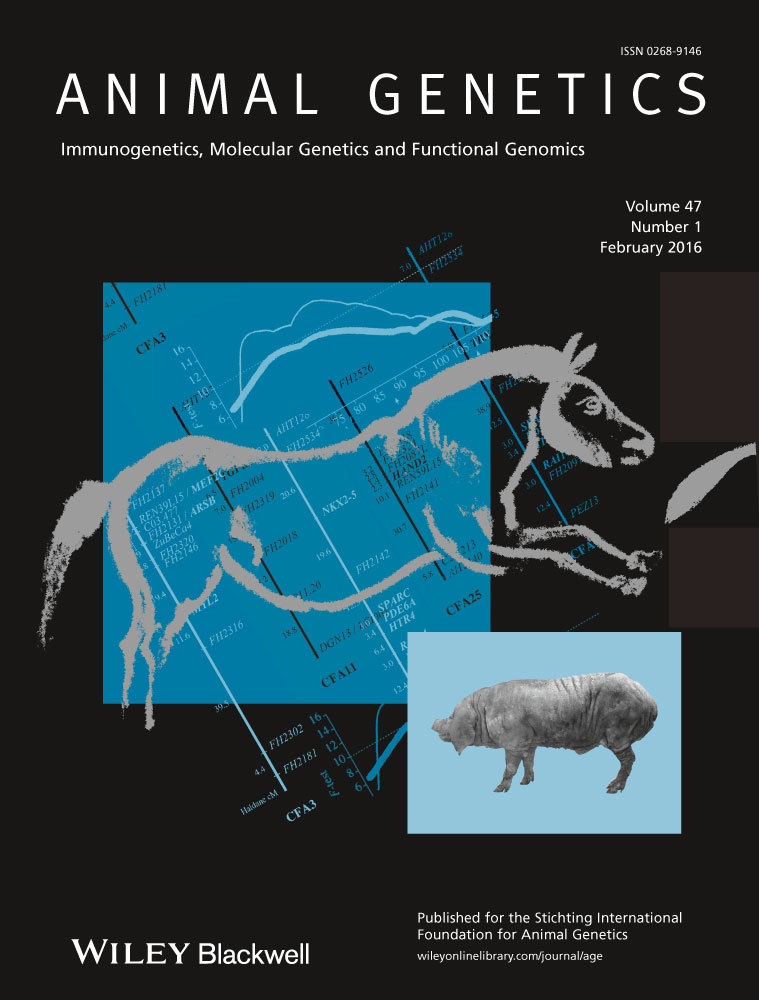A SNP in the porcine chemokine (C-X-C motif) ligand 10 gene is associated with blood hemoglobin concentration
Chemokine (C-X-C motif) ligand 10 (CXCL10) plays a critical role in immune response, such as mediating the development of inflammatory disease and contributing to viral replication limitation and clearance.1, 2 Also, CXCL10 is targeted by miR-21 and significantly inhibits pseudorabies virus replication in the porcine PK-15 cell.3 CXCL10 can be directly or indirectly induced after pathogen Toll Lire receptor activation.4 Exogenous CXCL10 was shown to resist viral replication after herpes virus infection of human neuron, and enhance the cellular immune response.5
Sequencing of the CXCL10 gene from 20 European Duroc and Chinese Erhualian pigs revealed a SNP, c.407T>C, in the 3′-UTR of the CXCL10 gene (dbSNP accession: NCBI_ss#CXCL10_-342). The SNP was detected in other pigs by PCR-RFLP with the primers AAGCAGAACTCAGACTGAAACC and GTAGAAGCCCACGGAGTAAAG and digestion by MspI which, for the C allele, generated fragments of 379 and 118 bp (Fig. S1). Allele frequencies were estimated for six breeds: Jinhua (n = 45), Jiaxing Black (n = 46), Shengxianhua (n = 33), Chalu Black (n = 37), Large White (n = 31) and Duroc (n = 37). The panel of 394 animals used in the association analysis consisted of eight Duroc sires, 18 Erhualian dams, 51 of their F1 crossbreds and 317 F2 offspring of 13 F1 sires and 38 F1 dams with minimized kinship.
The C allele was dominant in only two of the commercial pig breeds (Table S1). The association analysis results showed that this SNP was significantly associated with percentage of lymphocyte in blood of 20-day-old pigs and with hematocrit and mean red cell volume in blood of 80-day-old pigs (P < 0.05) but had the most significant associations with hemoglobin concentration in blood of 80-day-old pigs (P < 0.01; Table 1).
| Genotype | n | LY% (20 days) | HGB (80 days, g/l) | HCT (80 days, l/l) | MCV (80 days, fl) |
|---|---|---|---|---|---|
| TT | 34 | 71.41 ± 2.08a | 105.56 ± 4.14a | 37.37 ± 1.41a | 54.47 ± 1.07a |
| TC | 142 | 67.90 ± 1.31a,b | 121.77 ± 2.08b | 40.92 ± 0.71b | 56.84 ± 0.59b |
| CC | 212 | 65.93 ± 1.22b | 118.52 ± 1.84b | 39.32 ± 0.64a,b | 57.55 ± 0.53b |
| P-value | 0.0196* | 0.0022** | 0.0397* | 0.0238* |
- LY%, percentage of lymphocyte; HGB, hemoglobin concentration; HCT, hematocrit; MCV, mean red blood cell volume; fl, the unit of MCV.
- The same superscript letter in a column indicates no significant differences between the different genotypes.
- *Significant difference at P < 0.05 level; **significant difference at P < 0.01 level.
Comments
It has been described that red blood cells have a role in the immune response, which would suggest an effect of the C allele on the immune responses.6 The opposite effects of the SNP on white blood cells versus red blood cells may be dependent on the different age stage. If the association of the CXCL10 alleles on disease resistance can be verified, the SNP in the CXCL10 gene may be useful as marker for a quantitative trait locus with effects on blood parameter traits.
Acknowledgements
This work was supported by the Natural Science Foundation of China (31201784), the Natural Science Foundation of Zhejiang province (LQ12C17002) and the Agriculture (livestock) Breeding Major Science and Technology Special Foundation of Zhejiang province (2012C12906-8-1). We thank Jiucheng Chen (College of Animal Sciences of Zhejiang University) for helping with sample collection.




